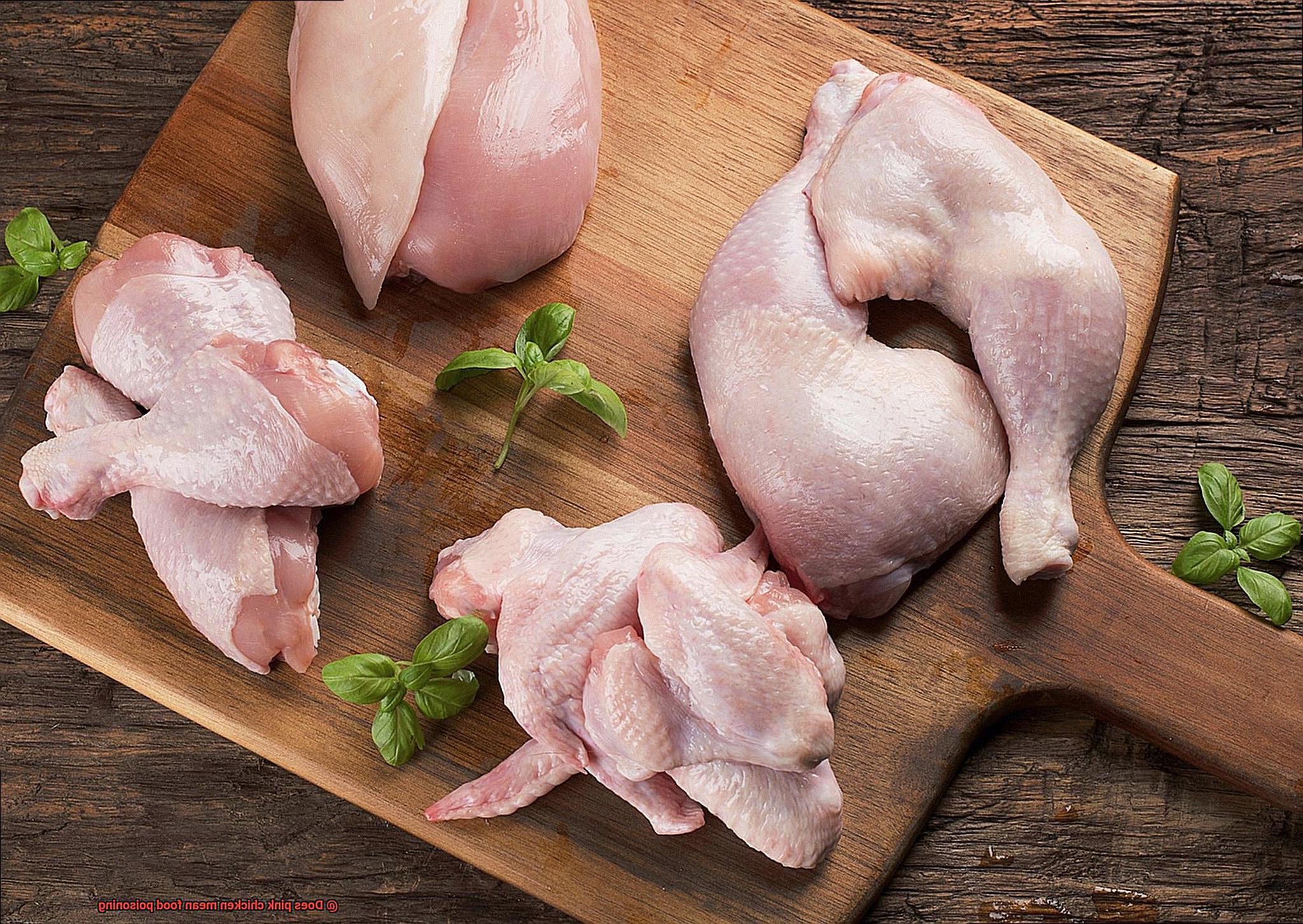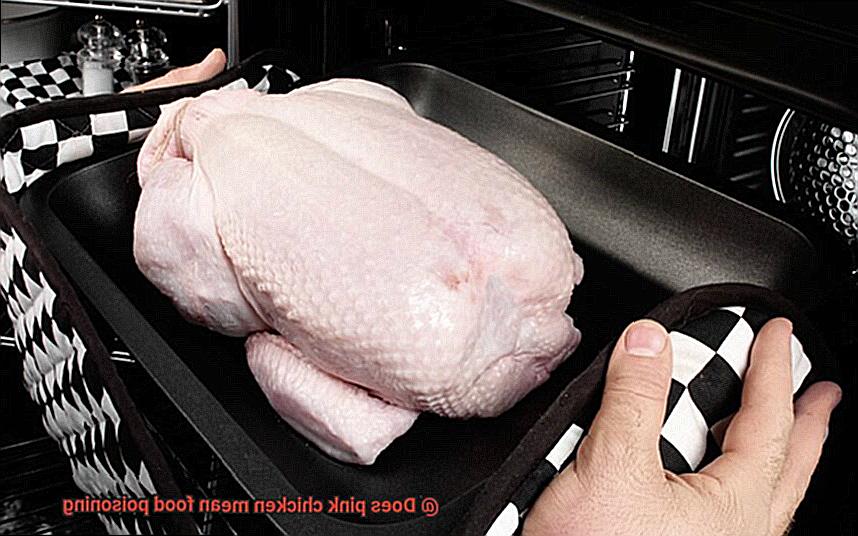Pink chicken. It’s a sight that can make even the strongest stomachs turn. Whether it’s a juicy grilled breast or a roasted leg, seeing pink flesh around the bone can cause some serious concern. And for good reason. Eating undercooked poultry can lead to food poisoning, which is no walk in the park.
But here’s the thing: Does pink chicken always mean you’re going to get sick? Well, it’s not always that simple. Sometimes, pink chicken isn’t a big deal, but other times, it could be an immediate red flag for food safety.
So how do you know when pink chicken is safe to eat and when it’s not? There are several factors to consider – cooking method, temperature, and time being some of the most important ones. If you want to keep yourself and your loved ones healthy after a meal, understanding these factors is critical.
That’s where this post comes in. We’ll delve into all the details so you can navigate the pink chicken conundrum with confidence. So if you’re curious about whether that rosy-hued poultry on your plate is safe or not, keep reading.

Contents
The Color of Chicken Does Not Necessarily Indicate Whether It Is Safe to Eat
When it comes to cooking chicken, many people think that the color of the meat is a reliable indicator of whether it’s safe to eat or not. However, this is not always the case. Chicken can come in a variety of colors, and its appearance isn’t always a reliable measure of its safety for consumption.
One reason why some chicken may have a pink or reddish hue is due to the presence of myoglobin. This protein is found in the muscles of chickens and other animals and gives meat its color. When cooked, myoglobin can change color and create a pink or reddish tint to the meat. This means that even if chicken appears pink, it may still be fully cooked and safe to eat.
On the other hand, chicken that appears fully cooked with no pink color may still contain harmful bacteria such as Salmonella or Campylobacter. These bacteria can cause food poisoning if ingested, even if the chicken appears fully cooked.
To ensure that your chicken is safe to eat, it’s important to use a food thermometer to check the internal temperature of the meat. The USDA recommends cooking chicken to an internal temperature of 165°F (74°C) to destroy any harmful bacteria.
In addition to using a thermometer, it’s crucial to practice safe food handling techniques when preparing and cooking chicken. This includes washing hands and surfaces that come into contact with raw chicken, storing it at the appropriate temperature, and using separate cutting boards and utensils for raw and cooked chicken. By following these practices, you can minimize your risk of exposure to harmful bacteria that can cause illness.
The Most Important Factor in Determining If Chicken Is Safe to Eat
While there are many factors to consider when handling and cooking chicken, the most important one is its internal temperature.
It’s easy to fall into the trap of relying on color as an indicator of doneness, but this can be deceiving. The appearance of pink or reddish hues in fully cooked chicken doesn’t always indicate food poisoning, as it could simply be caused by myoglobin. Conversely, fully cooked chicken without any pink may still harbor harmful bacteria such as Salmonella or Campylobacter that can cause illness.
To guarantee your chicken is safe to consume, it must be cooked to a minimum internal temperature of 165°F (74°C). This temperature is hot enough to kill any harmful bacteria that may be present. To check whether you have reached this temperature, use a meat thermometer and insert it into the thickest part of the chicken. Avoid touching bone or the pan, as this can give you an inaccurate reading.
Bear in mind that thorough cooking alone is not enough to prevent food poisoning when it comes to chicken. Proper handling and storage of raw chicken is also critical in preventing contamination and the growth of harmful bacteria. Always wash your hands and surfaces before and after handling raw chicken, and store it in the refrigerator or freezer promptly after purchase.
Cooking Chicken to the Appropriate Internal Temperature

Before you fire up the stove, be sure to understand the importance of cooking chicken to the appropriate internal temperature. Undercooked chicken can harbor harmful bacteria that can lead to food poisoning, so it is essential to ensure your chicken is cooked thoroughly.
According to USDA guidelines, the internal temperature of chicken should reach 165°F (or 75°C). Don’t rely on color as an indicator of doneness. While cooked chicken usually appears white or brown, it is still possible for properly cooked chicken to have a slight pink color. To accurately check the temperature of your chicken, use a meat thermometer. Simply insert it into the thickest part of the meat to get an accurate reading.
It’s also important to note that different parts of the chicken may cook at different rates. Chicken breasts, for instance, may cook faster than thighs or legs. To ensure all parts are safe to eat, check each piece individually and adjust cooking times accordingly. By doing this, you’ll be able to guarantee that each piece reaches the appropriate internal temperature and does not harbor any harmful bacteria.
Using a Meat Thermometer to Ensure Proper Temperature
Using a meat thermometer is the gold standard for ensuring that your chicken is cooked to the appropriate internal temperature. This is crucial because cooking chicken to the right temperature is the only way to kill any harmful bacteria that could cause food poisoning, such as Salmonella or Campylobacter.
Here’s how to use a meat thermometer like a pro:
- First, insert the thermometer into the thickest part of the chicken, being careful not to touch any bones. Bones conduct heat differently than meat and can give you an inaccurate reading.
- Wait for the thermometer to register the temperature. The USDA recommends cooking chicken to an internal temperature of at least 165°F (74°C) to ensure it’s fully cooked and safe to eat.
But what about pink chicken? Contrary to popular belief, a slight pink tint near the bone doesn’t necessarily mean it’s undercooked or unsafe to eat. This is because bones can release a pigment called myoglobin that can give the meat a pinkish hue. However, if you’re unsure whether your chicken is fully cooked, it’s always better to err on the side of caution and use a meat thermometer to check the internal temperature.
But wait, there’s more. Using a meat thermometer is just one piece of the puzzle in ensuring that your chicken is safe to eat. Here are some additional precautions you can take:
- Wash your hands and any surfaces that come into contact with raw chicken thoroughly with soap and hot water before and after handling it.
- Use separate cutting boards and utensils for raw chicken and other foods to avoid cross-contamination.
- Refrigerate raw chicken promptly and cook it within a few days of purchase to prevent harmful bacteria from growing.
Handling Raw Chicken Properly To Avoid Contamination
Did you know that handling raw chicken requires proper hygiene practices and cooking techniques to avoid contamination? Raw chicken contains harmful bacteria such as salmonella, which can cause food poisoning if not handled correctly. As an expert on handling raw chicken properly to avoid contamination, let me share with you some essential tips to keep in mind.
Storing raw chicken is crucial to prevent any juice from leaking onto other foods. It should be kept in a sealed container or wrapped tightly in plastic wrap. Also, store it on the bottom shelf of the refrigerator to avoid drips from contaminating other foods.
Washing your hands thoroughly before and after handling raw chicken is also crucial. This helps prevent cross-contamination and the spread of bacteria. Likewise, make sure to clean all utensils, cutting boards, and surfaces that come into contact with raw chicken with hot soapy water after use.

When cooking chicken, make sure to cook it thoroughly until it reaches an internal temperature of 165°F (74°C) to kill any harmful bacteria present. Using a meat thermometer is your best tool for achieving the perfect score in cooking chicken. Don’t be fooled by pink chicken, as it doesn’t necessarily mean food poisoning; but when in doubt, always use a meat thermometer.
Lastly, avoiding cross-contamination during cooking is vital. Use separate utensils for cooked and raw chicken and never mix them up as it can lead to contamination.
Washing Hands and Surfaces That Come into Contact with Raw Chicken
Raw chicken is a staple in many kitchens worldwide, but it’s also a breeding ground for harmful bacteria that can cause food poisoning. To avoid contamination and ensure the safety of your meals, it’s essential to properly wash your hands and surfaces that come into contact with raw chicken.
Let’s start with handwashing. It might seem like a simple task, but it’s often overlooked or not done correctly. To effectively wash your hands, use warm, soapy water and scrub for at least 20 seconds. Pay special attention to areas where bacteria can linger, such as under your fingernails and between your fingers. And don’t forget to wash again after handling the cooked chicken.
Now let’s talk about surfaces that come into contact with raw chicken. These include cutting boards, knives, and countertops. After each use, they should be washed thoroughly with warm, soapy water. To prevent cross-contamination, always use separate cutting boards and utensils for raw chicken and other foods. Consider using a plastic cutting board for raw chicken since it’s easier to sanitize than a wooden one.
Sanitizing surfaces and utensils is also crucial in preventing the spread of harmful bacteria. After washing, use a solution of one tablespoon of bleach per gallon of water or a commercial sanitizing solution to disinfect. Let the solution sit on the surface for a few minutes before rinsing it off.
Storing Raw Chicken at the Appropriate Temperature
Today, we’re diving into the critical topic of storing raw chicken at the appropriate temperature. It’s not just about tossing it in the fridge and calling it a day. Temperature control is key to preventing the growth of harmful bacteria like Salmonella and Campylobacter that can cause food poisoning.
To start with, let’s emphasize that raw chicken should be kept at or below 40°F (4°C) in the refrigerator and at or below 0°F (-18°C) in the freezer. This simple step can make a big difference in keeping your family healthy.
But there’s more to the story. Raw chicken should always be stored separately from other foods to avoid cross-contamination. Position it on the bottom shelf of your fridge and use a container or tray to catch any drips. This practice prevents any juices from spilling onto other foods and potentially causing illness.
Another common mistake people make is leaving raw chicken out at room temperature for too long. Bacteria can multiply rapidly in temperatures between 40°F and 140°F (4°C and 60°C), which is known as the “danger zone.” To limit the risk of contamination, put your chicken away quickly after purchasing or preparing it.
When it comes to thawing frozen chicken, remember that slow and steady wins the race. The best method is to thaw it slowly in the fridge, allowing enough time for it to defrost completely. If you’re short on time, thawing in cold water or using a microwave can be used as well, but always cook the chicken immediately after thawing using these methods.
Using Separate Cutting Boards and Utensils for Raw and Cooked Chicken
Chicken is a delicious and versatile protein-rich food that can be enjoyed in many different ways, from roasted to grilled. However, raw chicken can contain harmful bacteria such as Salmonella and Campylobacter, which can lead to food poisoning if not handled properly. That’s why it is crucial to use separate cutting boards and utensils for raw and cooked chicken.
Here are some reasons why this step is essential for your health and safety:
- Prevent cross-contamination: When you use the same cutting board or utensils for raw chicken and other foods like vegetables or fruits, you risk transferring harmful bacteria from the raw chicken to other foods. This can lead to food poisoning or other foodborne illnesses. By using separate cutting boards and utensils, you can prevent cross-contamination and keep your kitchen safe.
- Wash your hands: It is important to wash your hands thoroughly with soap and water before and after handling raw chicken. This will help prevent the spread of harmful bacteria to other surfaces in your kitchen.
- Separate cooked chicken: When it comes to cooked chicken, it is crucial to use a clean plate or cutting board and separate utensils to avoid any potential cross-contamination with raw chicken. This means not using the same tongs or fork that you used for raw chicken on your cooked chicken.
- Check the temperature: Always check the internal temperature of cooked chicken with a food thermometer to ensure it has reached a safe temperature of 165°F (74°C) to kill any harmful bacteria.
By following these simple steps, you can reduce the risk of food poisoning from contaminated chicken. While it may seem like an extra step in the cooking process, it is a necessary one to ensure the safety of yourself and those you are cooking for.
68ceagyO5aU” >
Conclusion
In summary, pink chicken does not necessarily mean food poisoning. While the presence of myoglobin can cause a pinkish hue in fully cooked chicken, harmful bacteria can still be present in fully cooked chicken without any pink. Therefore, it is important to use a food thermometer to ensure that the internal temperature of the meat reaches 165°F (74°C) to eliminate any potential risks.
Proper handling and storage of raw chicken are also crucial in preventing contamination and bacterial growth. Always remember to wash your hands and surfaces that come into contact with raw chicken, store it at or below 40°F (4°C) in the refrigerator, and use separate cutting boards and utensils for raw and cooked chicken.
Using a meat thermometer is the gold standard for ensuring that your chicken is safe to eat. Be sure to insert it into the thickest part of the meat while avoiding touching any bones. However, thorough cooking alone is not enough to prevent food poisoning from undercooked or contaminated chicken; proper handling and storage are equally important.
By following these best practices, you can significantly reduce your risk of illness from consuming undercooked or contaminated chicken. So next time you spot some pink hues in your cooked chicken, don’t panic.






